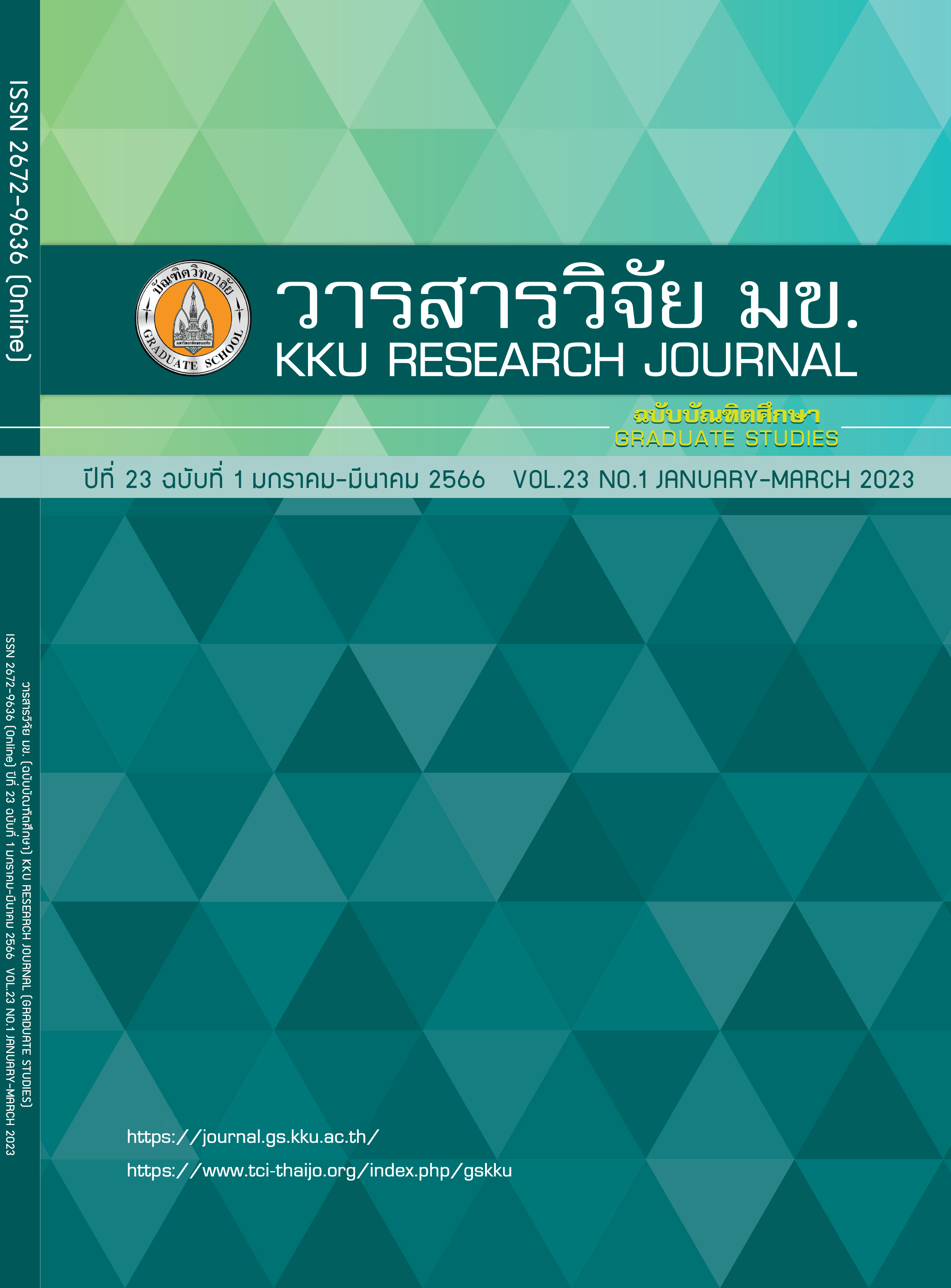Sulfide Removal Efficiency in Aqueous Solution with Synthetic Ion Exchanger from Litopenaeus vannamei Shrimp Shell
Keywords:
Ion Exchanger, Sulfide, Ion Exchange CapacityAbstract
The research objective is to synthesis ion exchanger from Litopenaeus vannamei shrimp shells for remove sulfide ion in aqueous solutions. The batch experiment revealed that the optimum conditions of synthetic ion exchanger 3.0 g, initial concentration of sulfide solution 0.5 mg/L and an ion exchange time 60 minutes at pH 4, the sulfide removal efficiency was 86.08±0.29% and an exchange capacity was 0.0016 mg/g. The column experiment which synthetic ion exchanger 3.0 g was packed, retention time 60, flow rate of 1.25 ml/min revealed that the sulfide removal efficiency was 97.71±0.09% and an exchange capacity was 0.0292 mg/g. In addition, the generation of used synthetic ion exchanger was investigated by 0.5 M and 1.0 M NaOH solution. The results found that the removal efficiency were 83.67±0.33% and 61.99±0.76%, respectively (p<0.05). The FTIR spectra confirmed that sulfide ion exchange process occurred because the absorption intensity of the amino group decreases after exchange sulfide ion in aqueous solution. Therefore, biosynthetic ion exchanger can be utilized to remove sulfide from aqueous solutions and can also add value to waste materials that must be disposed of further.
References
Nielsen AH, Vollertsen J, Jensen HS, Wium-Andersen T, Hvitved-Jacobsen T. Influence of pipe material and surfaces on sulfide related odor and corrosion in sewers. Water Research. 2008; 42(15): 4206-4214.
Altaş L, Büyükgüngör H. Sulfide removal in petroleum refinery wastewater by chemical precipitation. Journal of Hazardous Materials. 2008; 153(1): 462-469.
El Brahmi A, Abderafi S. Hydrogen sulfide removal from wastewater using hydrogen peroxide in-situ treatment: Case study of Moroccan urban sewers. Materials Today: Proceedings. 2021; 45: 7424-7427.
Promnuan K, O-Thong S. Biological hydrogen sulfide and sulfate removal from rubber smoked sheet wastewater for enhanced biogas production. Energy Procedia. 2017; 138: 569-574.
Juthong H, Chantutanon S, Pomnuy S, Buachoei J, Salaeh F. Investigation of cases death from fermented biogas at skim crepe rubber factory, Phangla subdristrict, Sadoa district, Songkhla on August 13-16, 2019. Journal of Disease Prevention and Control : DPC.2 Phitsanulok. 2020; 7(2): 1-13. Thai.
Inthong W. Sulfate removal from latex rubber industry wastewater by using Phuket incinerator fly ash [MSc thesis]. Songkhla: Prince of Songkla University; 2008. Thai.
Phawanna P, Bangbang W, Laemchieb P. Synthesis of cation exchange resis from water hyacinth chemically modified with citric acid. Science and technology nakhon sawan rajabhat university journal. 2017; 9(10): 17-30. Thai
Lankapon P. Situation of marine shrimp products in the first month of the year 2022 [Internet]. 2022 [updated 2022 Apr 30; cited 2022 Dec 22].Availble from : https://www.fisheries.go.th/strategy/ fisheconomic/Monthly%20report/Shrimp/1.กุ้งทะเล%203%20เดือน%2065.pdf
Tamariz E, Rios-Ramírez A. Biodegradation of medical purpose polymeric materials and their impact on biocompatibility. [internet]. 2013. [updated 2013 Jun 14; cited 2022. Jul 11]. Availble from: https://www.intechopen.com/chapters/45099
Pankhoyngam P. Efficacy of chitosan beads from marine animal shells for the adsorption of ammonia and formaldehyde gas. [MSc thesis]. Bangkok: Kasetsart University; 2009. Thai.
Thongmak K. Adsorption efficiency of Lead (II) Cadmium (II) and Copper(II) Ions in aqueous solution and chemistry laboratory wastewater by chitosan beads and derivative. [MSc thesis]. Bangkok: Kasetsart University; 2017. Thai.
Tanthulwet M. Water quality analysis handbook. 3rd ed. Bangkok: Chulalongkorn university Publishing; 2000.
Standard Methods Committee of the American Public Health Association, American Water Works Association, and Water Environment Federation. 4500-S2− sulfide In: Standard methods for the examination of water and wastewater. Washington DC: APHA Press; 2018.
Chatterjee S, Tran HN, Godfred O-B, Woo SH. Supersorption capacity of anionic dye by newer chitosan hydrogel capsules via green surfactant exchange method. ACS Sustainable Chemistry & Engineering. 2018; 6(3): 3604-3614.
Aroonrote N. Effects of cross-linked chitosan beads with epichlorohydrin and N-carboxymethyl on adsorption of Lead(II) ans Zine(II) ions from aqueous solutions and electroplating wastewater. [MSc thesis]. Bangkok: Kasetsart University; 2014. Thai.
Boontha S. Chitosan and trimethyl chitosan and their applications in pharmaceutics. Center for Continuing Pharmaceutical Education; 2017 Dec: 1-9. Thai.
Watcharin R. Organic Spectroscopy. 8th ed. Songkla: Prince of Songkla University; 2013.
Wang X, Tang R, Zhang Y, Yu Z, Qi C. Preparation of a novel chitosan based biopolymerdye and application in wood dyeing. Polymers (Basel). 2016; 8(338): 1-13.
Downloads
Published
Issue
Section
License
Copyright (c) 2023 KKU Research Journal (Graduate Studies)

This work is licensed under a Creative Commons Attribution-NonCommercial-NoDerivatives 4.0 International License.



